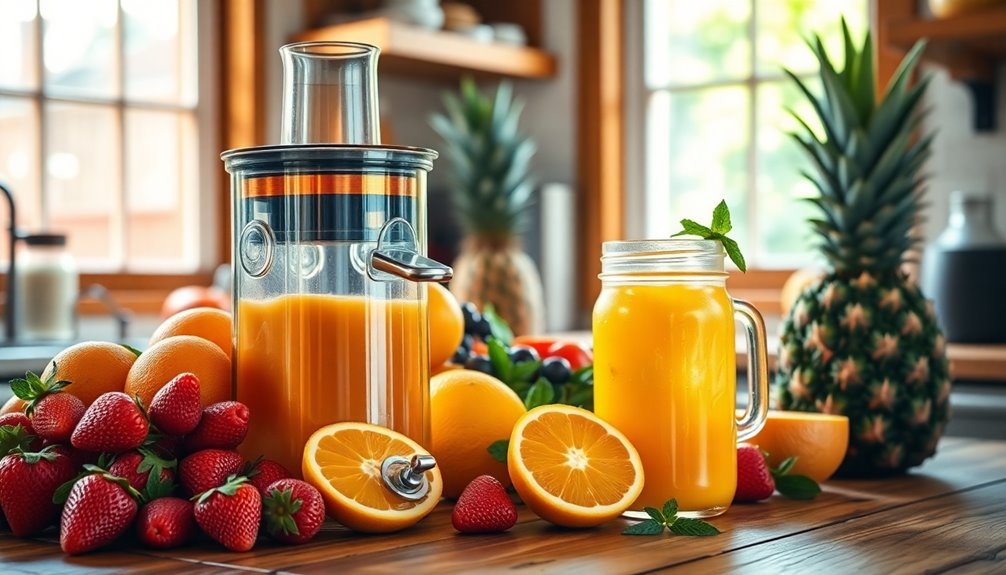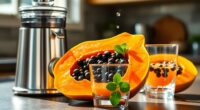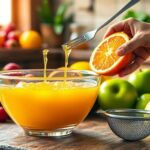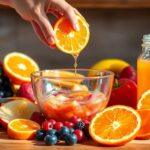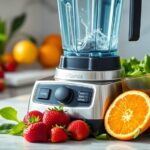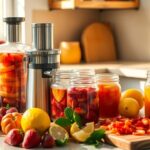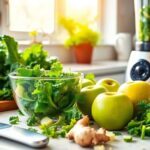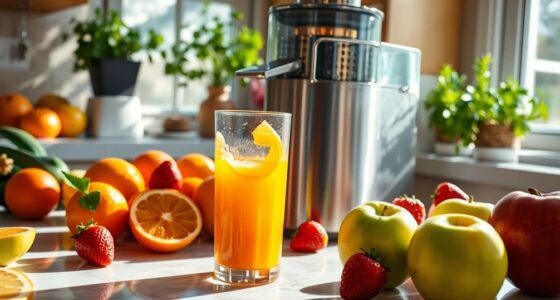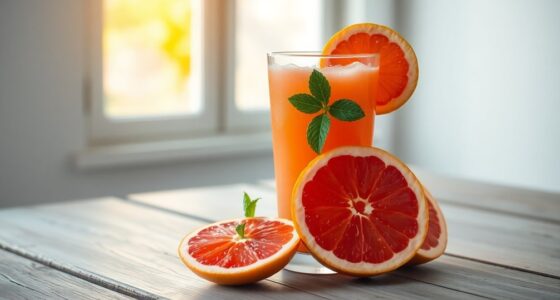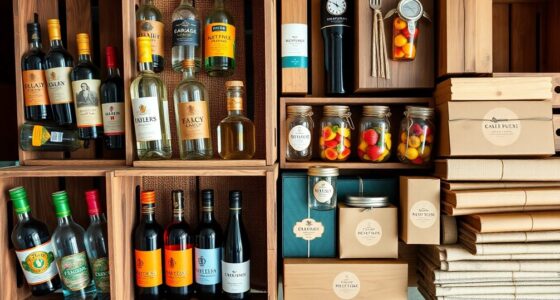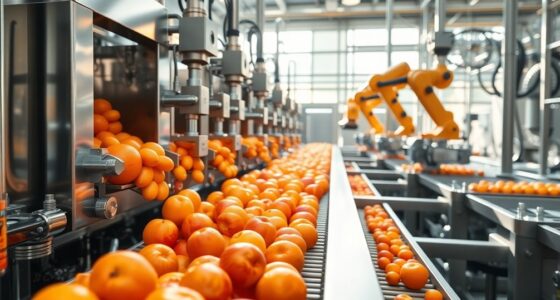You can create fresh fruit juice at home using simple methods! Try blending fruits in a high-speed blender or boiling apples for homemade apple juice. Don't throw away fruit scraps; cook them for delicious juice instead. For smoothie-like blends, mix your favorite fruits. Use a nut milk bag to strain your mixtures effectively. Enhance flavors with herbs and spices for a unique twist. Discover even more creative techniques to elevate your juice-making experience!
Key Takeaways
- Blend fruits and vegetables with water in a high-speed blender, then strain using a nut milk bag for smooth juice without a juicer.
- Boil chopped apples with water and cream of tartar, cool for 24 hours, and strain for homemade apple juice.
- Use fruit scraps like apple cores and pineapple peels, cook them, then strain for a sustainable juice option.
- Experiment with blending fruits like banana and spinach for nutrient-rich smoothies that retain fiber and flavor.
- Enhance juice flavors with herbs and spices, such as mint, ginger, or cinnamon, to create unique taste profiles.
How to Make Fresh Fruit Juice Without a Juicer
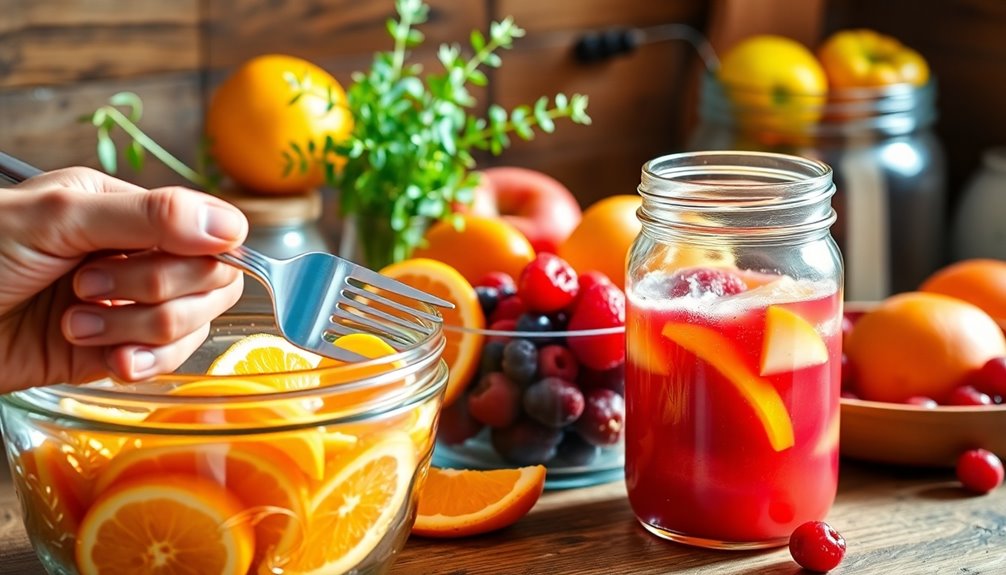
If you want to enjoy fresh fruit juice without investing in a juicer, you can easily make it at home with just a few simple steps. Start by selecting your favorite fruits, such as oranges, apples, or berries, and wash them thoroughly. Then, blend the fruits with a little water until smooth, and strain the mixture through a fine mesh sieve or cheesecloth to extract the juice. Not only is this method quick and convenient, but it also enhances the benefits of homemade fruit juice, as you can customize it to suit your taste and dietary needs. Plus, you’ll avoid the added sugars and preservatives often found in store-bought options.
Start by preparing your ingredients—cut and peel fresh produce like lemons, oranges, apples, ginger, and carrots.
Next, combine the prepared fruits and vegetables with water in a high-speed blender, blending at high speed for 2-3 minutes to achieve a smooth consistency.
After blending, strain the juice using a nut milk bag, fine mesh strainer, or cheesecloth to separate the liquid from the pulp.
Discard the pulp and transfer the freshly strained juice into glass jars or juice bottles.
Additionally, experimenting with unique combinations of fruits can enhance the flavor profiles of your juices.
Store your homemade fresh juices in an airtight container in the refrigerator for 3-5 days, enjoying the deliciousness!
Making Apple Juice From Scratch
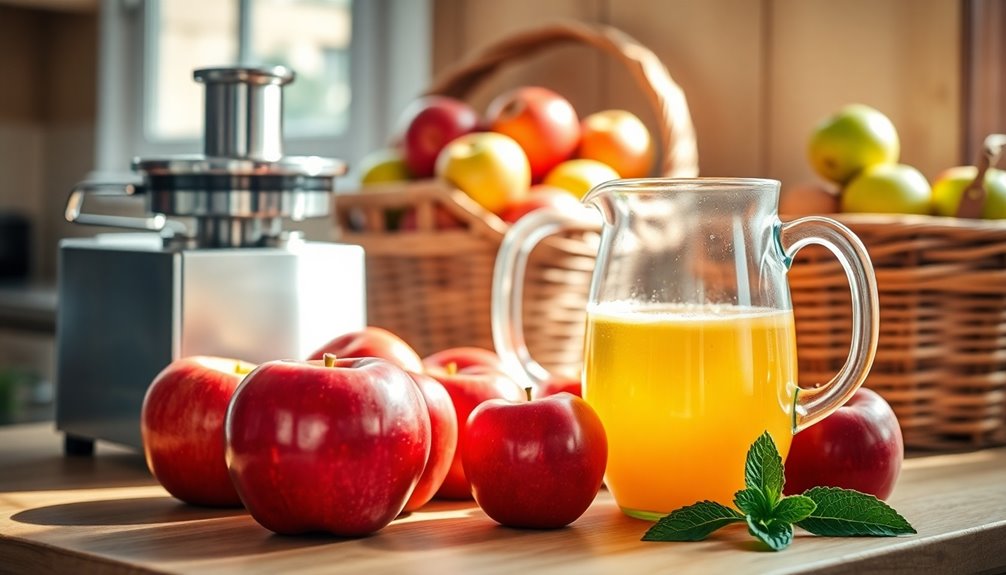
When you're making apple juice from scratch, choosing the right apples is essential for the flavor you want.
You'll want to explore different juicing techniques to get the most out of your fruit.
Plus, knowing how to store your juice properly will keep it fresh and delicious for days. Additionally, incorporating detoxifying juices into your routine can enhance overall health and wellness.
Selecting the Right Apples
Selecting the right apples is essential for making delicious apple juice from scratch. Here are some tips to help you choose the best fruits:
- Sweet vs. Tart: Opt for sweet varieties like Red Delicious, Gala, or Golden Delicious for a sweeter juice. If you prefer tanginess, go for Granny Smith or Pink Lady apples.
- Color Matters: Red apples produce a deeper juice hue, while green apples yield a lighter, vibrant color.
- Fresh and Firm: Always select fresh, firm apples without bruises or blemishes to guarantee peak flavor and nutrient retention. Additionally, using apples high in antioxidants can enhance the health benefits of your juice.
Juicing Techniques and Methods
Now that you've picked the perfect apples, it's time to turn them into delicious juice. Start by cutting 5 cups of apples into pieces. If your apples are waxed, soak them to verify they're clean.
Next, boil the apple pieces with 2 teaspoons of cream of tartar and 10 cups of water. Cover and simmer for about 15 minutes to extract flavors.
Once done, let the mixture cool for 24 hours to enhance its taste. After cooling, strain the juice using a fine mesh strainer or cheesecloth.
For a touch of sweetness, mix in 1/2 cup of sugar and 2 tablespoons of lemon juice if desired. Additionally, using organic fruits and vegetables can ensure your juice is free from pesticides and chemicals. Now you've made homemade juice that's invigorating and satisfying!
Storage Tips for Freshness
To keep your freshly made apple juice tasting its best, proper storage is key. Here are some essential storage tips for freshness:
- Use Airtight Glass Containers: Store your juice in airtight glass containers to prevent oxidation, which can alter flavor and color.
- Refrigerate Immediately: Always refrigerate the juice right after preparation and aim to consume it within 3-5 days for ideal taste and nutrient retention.
- Consider Freezing: For longer storage, freeze apple juice in ice cube trays. This way, you can easily add it to smoothies or recipes later.
If you notice sediment, gently shake the container before serving. Additionally, keeping your juice cold can help maintain its nutritional value, ensuring you enjoy all the health benefits it offers.
Avoid plastic containers, as they can leach chemicals that compromise the quality of your juice.
Creating Juice From Fruit Scraps
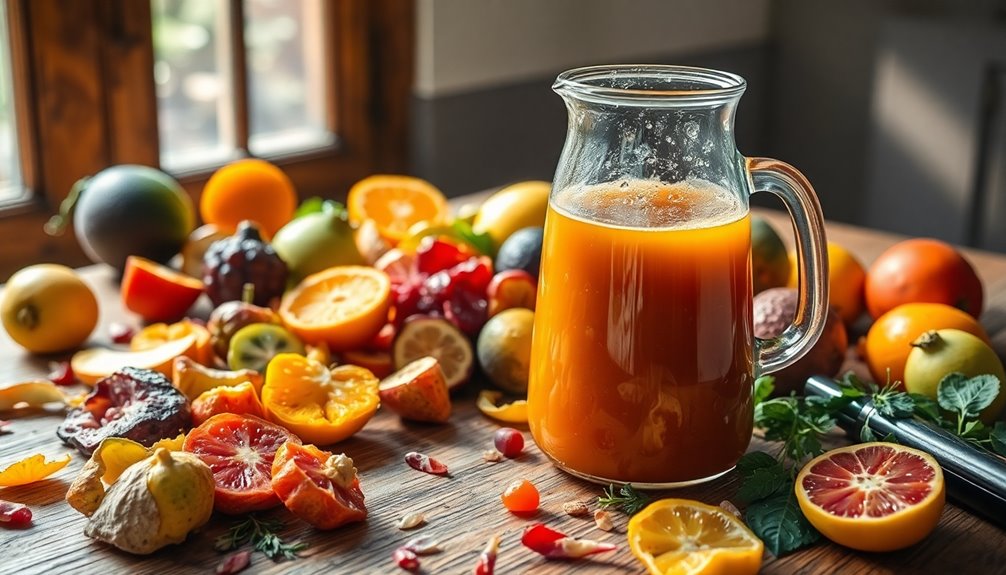
While you might usually toss out fruit scraps like apple cores and pineapple peels, these leftovers can be transformed into delicious juice with just a bit of effort.
Start by collecting scraps such as pear skins and freezing them until you have enough. To make fruit juice, cook the scraps in a crock pot with water on high for a few hours, or boil and simmer for about an hour to extract as much juice as possible.
Once cooked, strain the liquid using a colander and cheesecloth to separate the juice from the leftover pulp. For added flavor, consider adding spices like cinnamon or ginger during the cooking process. Just remember to avoid using citrus peels to prevent bitterness! Additionally, be mindful of factors affecting shelf life of juices to ensure your homemade juice stays fresh and tasty.
Blending Fruits for Smoothie-like Juices
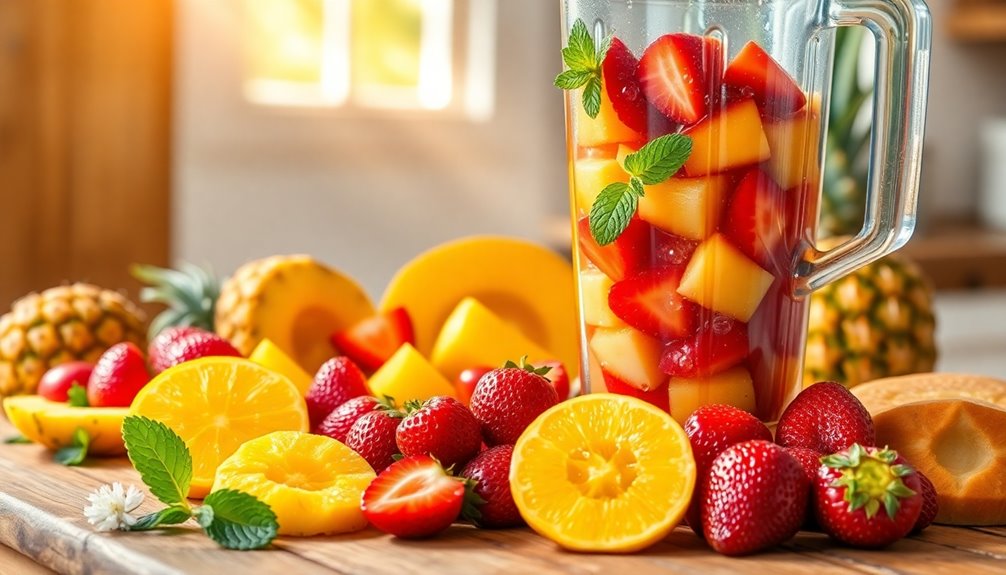
Blending fruits for smoothie-like juices is a great way to enjoy thick, nutrient-rich drinks.
You can experiment with various fruit combinations to discover unique flavors while also gaining the nutritional benefits they offer. Additionally, incorporating leafy greens can enhance the nutrient profile of your smoothies, providing high vitamins and antioxidants that promote overall health.
Let's explore the differences between smoothies and juices, the best fruit pairings, and how these choices impact your health.
Best Fruit Combinations
- Banana, Spinach, and Pineapple – A nutrient-rich blend high in potassium and vitamins A and C.
- Apples with Berries – Mix strawberries or blueberries for a delicious juice with a sweet and tart flavor full of antioxidants.
- Watermelon and Mint – This invigorating duo hydrates while adding a unique, low-calorie flavor twist.
Experiment with these combinations, and you'll discover how easy it's to create delicious juice that boosts your health! Including chia seeds in your juice can also enhance its nutritional profile with added omega-3 fatty acids and fiber.
Smoothie vs. Juice
Juicing and making smoothies are both popular ways to enjoy fruits, but they offer different experiences and benefits.
If you're after a smooth juice that retains more fiber, consider blending whole fruits and vegetables instead of straining them. This method creates a creamy, satisfying drink—perfect for those who love smoothies.
Add ingredients like banana or yogurt for extra nutrients and a richer texture. You can customize your homemade fruit juice with various combinations, enhancing flavors and health benefits to match your preferences.
Using a high-speed blender guarantees a silky consistency, even with tough greens. Plus, incorporating liquids like coconut water or almond milk can elevate flavor and hydration, keeping your drink light and invigorating. Additionally, you might consider using natural sweeteners to enhance the flavor without added sugars.
Nutritional Benefits Explained
Creating smoothie-like juices not only satisfies your taste buds but also packs a nutritional punch. By blending fruits and veggies, you reveal a wealth of health benefits.
Here are three key advantages:
- Fiber-Rich: Retaining fiber aids digestion and keeps you feeling full longer.
- Vitamins Galore: Ingredients like bananas, apples, and leafy greens boost your intake of vitamins A, C, and K, which support immune health and skin well-being.
- Antioxidants: Using vibrant fruits such as berries enhances antioxidant levels, helping combat inflammation.
Incorporating essential oils like lavender and chamomile into your routine can also promote relaxation and calmness.
Try incorporating healthy fats like avocado or nut butters in your juice recipe to improve vitamin absorption and sustain energy.
Embrace these nutritional benefits for a deliciously healthy lifestyle!
Cooking and Boiling Fruit for Juices
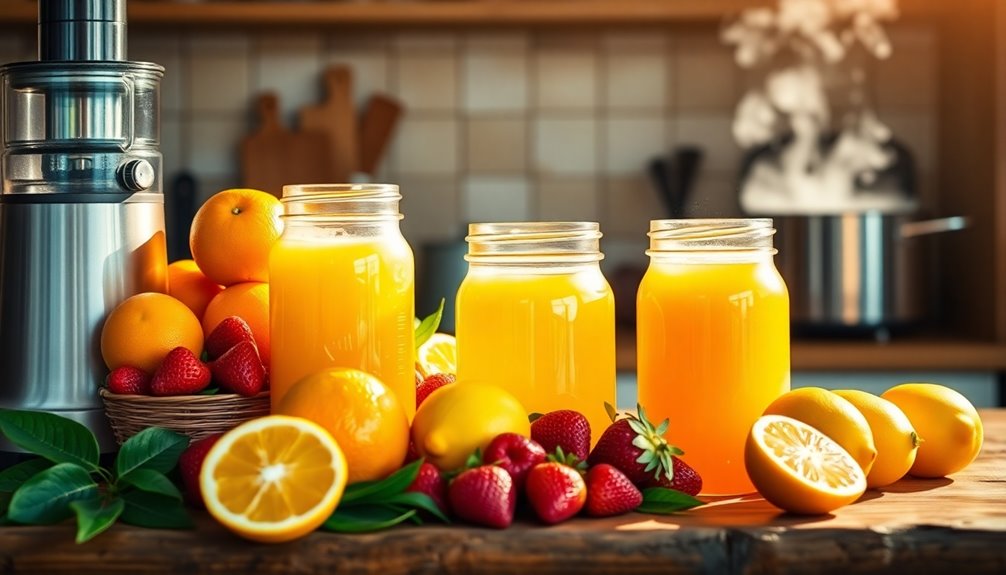
Boiling fruit is a fantastic way to extract rich flavors and nutrients for your homemade juices. Start by chopping your fruit, like apples, and place it in a pot with some water. Cook the fruit on medium heat for about 15 minutes, adding cream of tartar to enhance the flavor and maintain the apples' color.
Once cooked, let the mixture cool for 24 hours to deepen the taste. Afterward, pour the mixture through a colander lined with cheese cloth to separate the juice from the pulp, maximizing extraction.
If you prefer a sweeter juice, feel free to add sugar or lemon juice after straining. Chill your delicious juice and enjoy the fresh taste of your homemade creation!
Using a Nut Milk Bag for Straining Juice
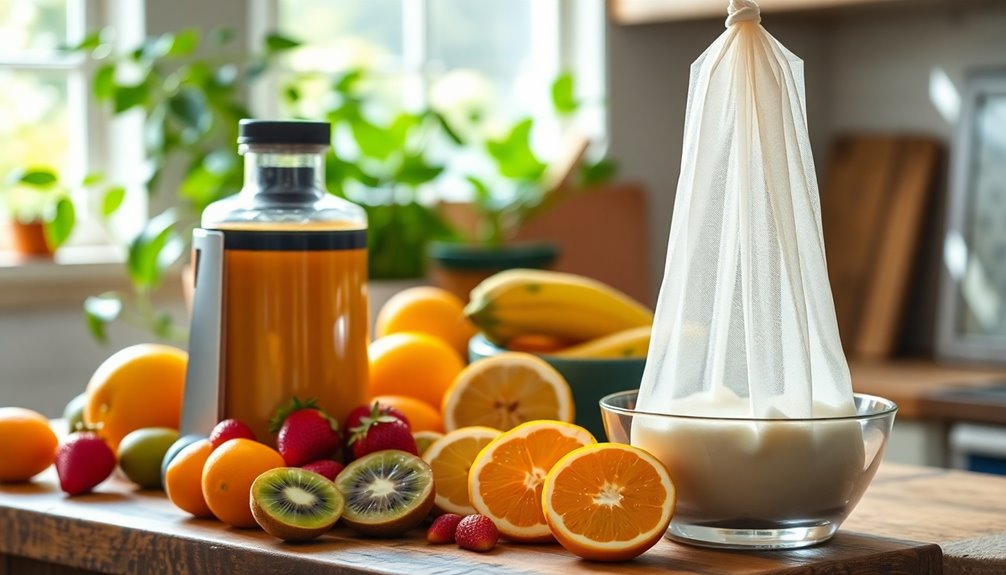
After you've boiled your fruit to enhance its flavor, straining the juice properly is the next step to achieving a smooth, invigorating drink.
A nut milk bag is perfect for this task, allowing you to strain juice effectively while maximizing juice extraction. Here's how to use it:
- Pour your blended mixture into the nut milk bag.
- Let it sit for a minute to allow for maximum juice extraction.
- Gather the top of the bag and gently squeeze to strain juice into a bowl or container.
These bags are reusable, made of durable nylon or cotton, and easy to clean.
Just wash them in warm soapy water or toss them in the dishwasher for convenience. Enjoy your fresh juice!
Exploring Flavor Combinations With Herbs and Spices
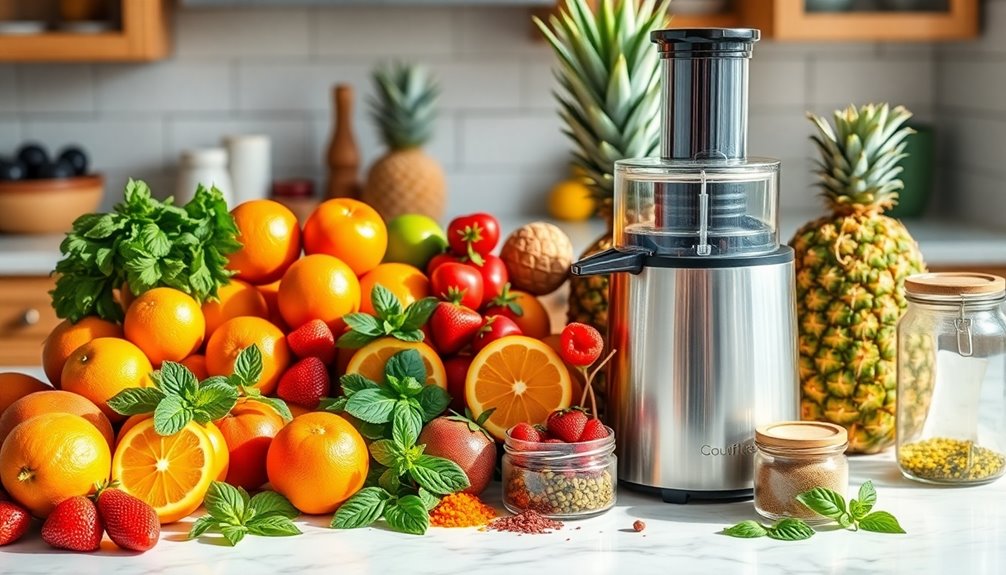
When you want to elevate the taste of your fresh fruit juice, incorporating herbs and spices can make a world of difference. Fresh herbs like mint, basil, or rosemary add invigorating twists, while spices such as cinnamon and ginger offer warmth and health benefits. Experimenting with citrus zest brightens flavors, creating zesty kicks that balance sweetness.
Here's a quick guide to flavor combinations:
| Fruit | Herb/Spice | Flavor Profile |
|---|---|---|
| Apple | Cinnamon | Sweet and Warm |
| Pineapple | Mint | Sweet and Invigorating |
| Orange | Ginger | Sweet and Spicy |
| Watermelon | Basil | Sweet and Savory |
| Lemon | Rosemary | Tart and Earthy |
Infuse flavors by steeping ingredients overnight for a deliciously unique juice experience!
Frequently Asked Questions
What Are the Methods of Making Fruit Juice?
You can make fruit juice using several methods.
First, try blending chopped fruits with water, then strain the mixture.
Alternatively, cook chopped fruit with water for a sweeter flavor.
If you have citrus fruits, a manual juicer can extract fresh juice easily.
For a slow method, use a crock pot with fruit scraps.
Finally, let freshly pressed juice ferment at room temperature for a probiotic-rich drink.
Each method offers a unique taste experience!
Is the Fresh Juice Business Profitable?
Yes, the fresh juice business can be highly profitable.
With the growing demand for healthy and organic products, you'll find consumers willing to pay more for freshly squeezed juice.
Starting this type of business often requires a lower initial investment in equipment compared to other food ventures.
How to Create Your Own Juice?
So, you want to create your own juice? Imagine this: you're a mad scientist in your kitchen, chopping fruit like a culinary ninja.
Gather your ingredients—apples, lemons, ginger—and toss them into a high-speed blender.
Blend it up for a few minutes, then strain it like a pro.
Voilà! You've got fresh juice!
Store it in those fancy jars and sip your masterpiece while contemplating your newfound juice wizardry.
Enjoy!
How to Can Fruit Juice at Home?
To can fruit juice at home, start by preparing your juice from fresh fruit, straining out any pulp for clarity.
Use sterilized glass jars, filling them up to 1/2 inch from the top.
Process the jars in a boiling water bath for 10-15 minutes, depending on your altitude.
After they cool, check the seals.
Store your sealed jars in a cool, dark place, and enjoy your juice within a year for best flavor.
Conclusion
Now that you've explored these seven DIY methods for fresh fruit juice production, you can blend, strain, and create delicious beverages right at home. Whether you're making juice from whole fruits, scraps, or even experimenting with flavors, each method brings unique tastes and textures to your table. So grab your fruits, embrace your creativity, and enjoy the revitalizing results of your labor. Cheers to your juicy adventures and the vibrant flavors waiting to be discovered!
Cindy thoroughly researches juicing trends, techniques, and recipes to provide readers with practical advice and inspiration. Her writing style is accessible, engaging, and designed to make complex concepts easy to understand. Cindy’s dedication to promoting the advantages of juicing shines through her work, empowering readers to make positive changes in their lives through the simple act of juicing.

